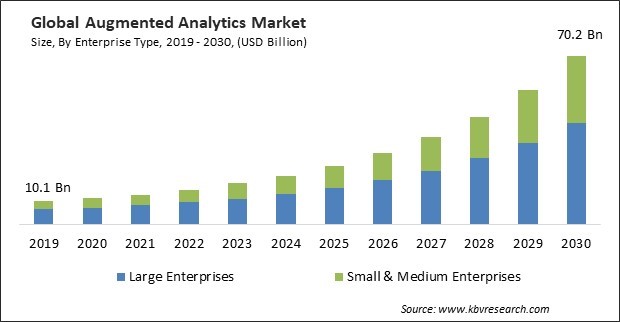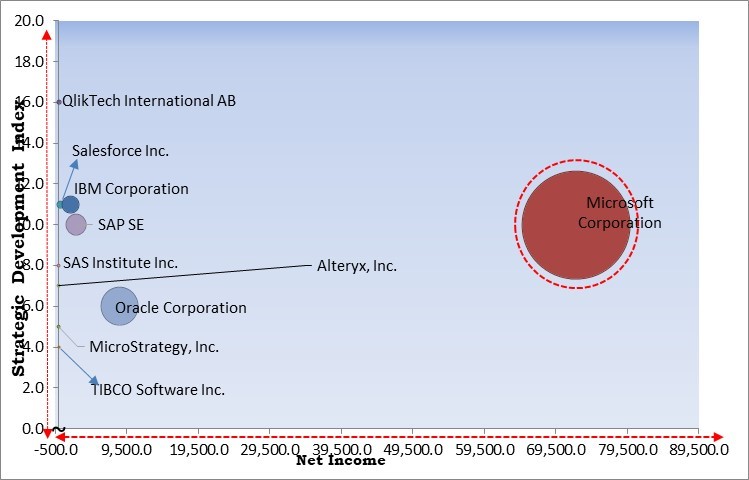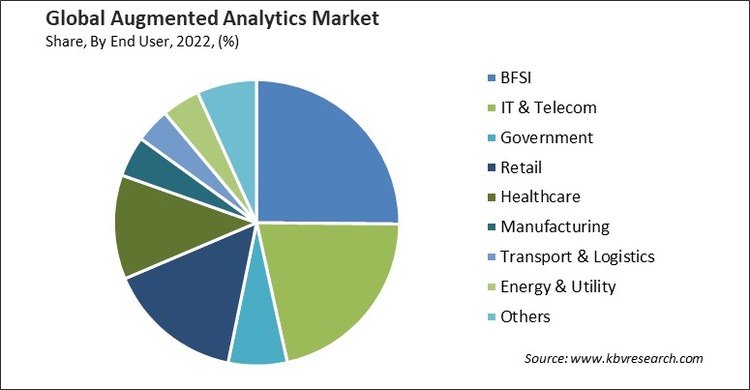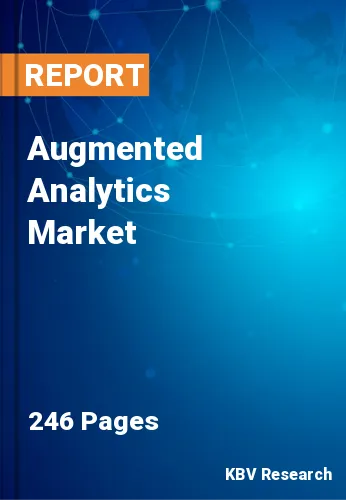The Global Augmented Analytics Market size is expected to reach $70.2 billion by 2030, rising at a market growth of 22.3% CAGR during the forecast period.
Businesses in the retail sector must comprehend consumer behavior and preferences. Augmented analytics helps retailers make data-driven decisions that improve efficiency and reduce operational costs. Consequently, the retail segment captured $2,248.3 in the market in 2022. Retailers are leveraging augmented analytics to gain deeper insights into their operations. They use data analysis to optimize inventory management, supply chain processes, and pricing strategies. Augmented analytics tools enable retailers to analyze large volumes of customer data, such as purchase history, online behavior, and feedback. This analysis helps retailers personalize marketing efforts and enhance the customer experience.

The major strategies followed by the market participants are Partnerships as the key developmental strategy to keep pace with the changing demands of end users. For instance, In October, 2023, MicroStrategy, Inc. partnered with Microsoft, to integrate its advanced analytics capabilities Microsoft's with Azure OpenAI Service. The partnership aids MicroStrategy in strengthening its analytics platform, MicroStrategy ONE. However, In August, 2023, IBM Corporation partnered with Salesforce, an American software company, to aid businesses worldwide in AI integration into their CRM systems.
Based on the Analysis presented in the KBV Cardinal matrix; Microsoft Corporation is the forerunner in the Market. Companies such as Oracle Corporation, SAP SE, IBM Corporation are some of the key innovators in the Market. For Instance, In June, 2023, Salesforce, Inc. came into partnership with Google Cloud, a cloud platform offered by Google. The two companies aimed to facilitate businesses in enhancing their CRM systems by including data and AI tools in them.

Countless amounts of data are being gathered and stored by enterprises as part of digital transformation activities. They require advanced analytics tools to extract meaningful insights and drive informed decisions. With its automation and predictive capabilities, it helps organizations leverage this data effectively. Digital transformation often focuses on improving the customer experience. It plays a crucial role in this by analyzing customer data to understand preferences and behaviors. This enables organizations to provide more personalized and tailored experiences central to digital transformation efforts. Digital transformation often involves adopting cloud technologies and expanding digital infrastructures. This enhances the requirement for strong data security and adherence to laws like GDPR and HIPAA. These tools offer advanced security features to protect sensitive data and ensure regulatory compliance. Therefore, these factors will drive the demand for these analytics in the coming years.
The user-friendly nature of these tools means that a broader range of professionals, beyond data scientists and analysts, can use these tools. This widens the potential user base for augmented analytics, increasing its adoption across various industries and sectors. Traditional data analysis methods often required extensive training and expertise, limiting the number of individuals who could effectively use these tools. It lowers the skill barriers, making data analysis accessible to professionals with varying levels of technical expertise. This means that more people within an organization can actively engage in data analysis without undergoing extensive training, thus speeding up the adoption process. The democratization of data analysis encourages the development of a data-driven culture within organizations. When employees at various levels can easily access and analyze data, it becomes an integral part of their decision-making processes. This cultural shift fosters a more innovative and agile organization. As a result, these factors will help in the expansion of the market in the coming years.
Stricter data privacy regulations, such as GDPR in Europe and CCPA in California, require organizations to adhere to stringent data protection measures. Complying with these regulations often entails significant costs, including investments in data encryption, secure storage, and legal consultation. This can increase the overall cost of implementing these solutions, discouraging some organizations from adopting them. Enhanced data privacy measures can make it more challenging for augmented analytics tools to access and analyze certain data, especially when it contains personal or sensitive information. This limitation can hinder the comprehensive data analysis, reducing the potential insights generated. Organizations must carefully manage data access, permissions, and encryption to ensure compliance. Due to this complexity, the implementation and maintenance of these tools may be difficult. Owing to these factors, the augmented analytics market can witness decreased demand in the upcoming years.

The leading players in the market are competing with diverse innovative offerings to remain competitive in the market. The above illustration shows the percentage of revenue shared by some of the leading companies in the market. The leading players of the market are adopting various strategies in order to cater demand coming from the different industries. The key developmental strategies in the market are Partnerships, Collaborations & Agreements.
On the basis of end user, the market is divided into BFSI, IT & telecom, government, retail, healthcare, manufacturing, transport & logistics, energy & utility, and others. The BFSI segment recorded the maximum revenue share in the market in 2022. In the highly competitive and data-centric world of banking and finance, data-driven decision-making is imperative. The BFSI sector places a strong emphasis on risk assessment and management. Augmented analytics aids in predictive modeling and the identification of potential risks. It enables financial institutions to create more accurate risk profiles and react swiftly to market fluctuations. As a result, there will be increased demand in the segment.

Based on enterprise type, the market is segmented into large enterprises and small & medium enterprises. In 2022, the small and medium enterprises segment garnered a significant revenue share in the market. These solutions are becoming increasingly affordable and accessible to SMEs. Many vendors offer cloud-based, subscription-based models, allowing SMEs to access advanced analytics tools without substantial upfront investments in hardware or software. This cost-effectiveness is a significant incentive for SMEs to adopt augmented analytics. Therefore, the segment will grow rapidly in the upcoming years.
| Report Attribute | Details |
|---|---|
| Market size value in 2022 | USD 14.6 Billion |
| Market size forecast in 2030 | USD 70.2 Billion |
| Base Year | 2022 |
| Historical Period | 2019 to 2021 |
| Forecast Period | 2023 to 2030 |
| Revenue Growth Rate | CAGR of 22.3% from 2023 to 2030 |
| Number of Pages | 246 |
| Number of Table | 313 |
| Report coverage | Market Trends, Revenue Estimation and Forecast, Segmentation Analysis, Regional and Country Breakdown, Market Share Analysis, Competitive Landscape, Companies Strategic Developments, Company Profiling |
| Segments covered | Enterprise Type, End User, Region |
| Country scope | US, Canada, Mexico, Germany, UK, France, Russia, Spain, Italy, China, Japan, India, South Korea, Singapore, Malaysia, Brazil, Argentina, UAE, Saudi Arabia, South Africa, Nigeria |
| Growth Drivers |
|
| Restraints |
|
By region, the market is segmented into North America, Europe, Asia Pacific, and LAMEA. The North America segment procured the highest revenue share in the market in 2022. The region has seen a surge in developing and adopting advanced technologies, including artificial intelligence (AI), machine learning, and natural language processing (NLP). They understand the importance of data analysis in gaining a competitive edge and making informed decisions. It offers a more accessible and efficient way to analyze data, making it a natural fit for this environment. These aspects are expected to increase the demand in the North America segment.
Free Valuable Insights: The Global Augmented Analytics Market size to reach USD 70.2 Billion by 2030
The market research report covers the analysis of key stake holders of the market. Key companies profiled in the report include QlikTech International AB, Salesforce Inc., IBM Corporation, Microsoft Corporation, Oracle Corporation, TIBCO Software Inc., SAP SE, SAS Institute Inc., MicroStrategy, Inc. and Alteryx, Inc.
By Enterprise Type
By End User
By Geography
This Market size is expected to reach $70.2 billion by 2030.
Rising Demand Due to Digital Transformation Across Industries are driving the Market in coming years, however, Rising Concerns Over Data Privacy and Security restraints the growth of the Market.
QlikTech International AB, Salesforce Inc., IBM Corporation, Microsoft Corporation, Oracle Corporation, TIBCO Software Inc., SAP SE, SAS Institute Inc., MicroStrategy, Inc. and Alteryx, Inc.
The expected CAGR of this Market is 22.3% from 2023 to 2030.
The Large Enterprises segment is leading the Market, By Enterprise Type in 2022, thereby, achieving a market value of $42,386.8 million by 2030.
The North America region dominated the Market, By Region in 2022, and would continue to be a dominant market till 2030; thereby, achieving a market value of $25,569.3 million by 2030.
Our team of dedicated experts can provide you with attractive expansion opportunities for your business.

